Have you noticed that the funnels on some of your favorite ships look strange? On this week’s Weekly Wednesday, we’re going to dive deeper into the design for the most popular funnels and try to understand why they look the way they do!
While it is a statement on the vessels we sail on today, the funnel has quite a history with ships, originally serving as a way for exhaust gases to be lifted so they would not cause damage to the ship’s structure or decks, and by removing smoke on deck improving the ability for the crew to be able to carry out their duties. In the 19th century, steam-powered ships helped pave the way for the modern-day cruise liners in how they are easily recognized thanks to its silhouetted appearance with the funnels.
The funnel was an early form of trademark for companies. They would specially design their funnels to be unique and different from other liners as this was something they could incorporate into marketing and publicity materials when offering sailings. As ships evolved and got bigger, they wanted to update their looks. Some of the builders incorporated multiple funnels with some being just for visuals to balance the appearance of the ship.
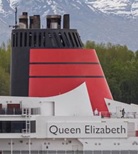
Cunard
One of the companies that led this revolution to making their funnels distinctive was Cunard Line. They have been sailing since 1840 when they introduced the design of a red funnel with two or three narrow black bands and a black top.
Disney
One company that will never be outdone by design is Disney. Several weeks ago, I outlined what made Disney Cruise Lines so unique, but there wasn’t much discussion about the design of the funnels on their ships. Step back to 1998 when they introduced their very first ship, Disney Magic. While built for speed and aesthetic, the ship was outfitted with two funnels. Both funnels are similar in that they share the iconic silhouetted Mickey Mouse head logo in white, on a triple blue-stripe wave over a red-painted funnel, however the forward funnel doesn’t function as a means of exhaust from the propulsion system. Housed inside the forward funnel on the Magic-Class ships is a teen center with a lounge and other activities.

P&O Cruises
Up until 2014, P&O Cruises sailed with a yellow funnel. When they decided to renovate the MV Aurora in 2014, one major change that the drydock saw with the introduction of the signature British Union Flag (the red, white, and blue flag that represents the United Kingdom) painted on her bow and blue on her funnel featuring P&O’s illuminated rising sun motif, which pays homage to the Oriental part of Peninsular and Oriental (P&O).
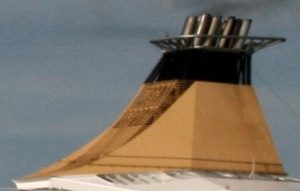
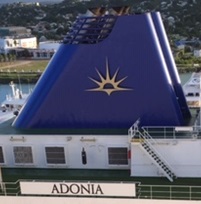
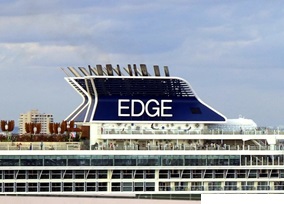
Celebrity Cruises
Originally founded in 1988 as a subsidiary of the Greece-based Chandris Group, Celebrity Cruises was formed to operate a higher-class of cruise ships to Bermuda. Currently owned by Royal Caribbean Group, the Celebrity ships were given an iconic funnel right out of the gate. On their funnel is displayed a giant “X” which is the Greek letter chi, for “Chandris”. Over the years, the design has evolved to become more prominent and incorporated into the funnel’s appearance. Originally it was a dark-blue painted funnel with a giant white “X” on it, and the funnel is now built in the shape of a giant “X” to really distinguish itself.

Costa Cruises
Some cruise lines are so proud of the funnel designs their ships feature that it’s part of their branding logo. Costa Cruises is one of those lines with their iconic yellow funnel with a dark blue “C” and black tips. This design has ben in use on their ships since the 1940s, or even earlier.
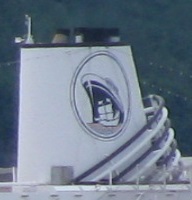
Princess Cruises, Royal Caribbean, Holland America Line, TUI Cruises & More
The various lines in this section all use their respective logos to represent who the ship belongs to. Their funnels are more similar in design. Princess Cruises utilizes a design with a white background set onto a sweeping arc with the lady of the seas (Princess Cruises logo) spread across the funnel. Royal Caribbean has featured several different funnel designs, but theirs are similar to TUI Cruises with their white-stacked funnel that features the crown and anchor of Royal Caribbean, and the TUI logo on theirs. Holland America Line usually features a single funnel, or a pair of funnels side-by-side. They are painted white, stand tall and feature the famed logo since the 1980s.
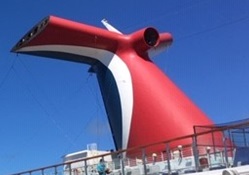
Carnival Cruise Line
Of course, the most prominent and easily recognizable funnel was saved for last: Carnival Cruise Line’s whale-tale funnel. Rather than placing the logo for the company directly onto their funnel, designer Joseph Farcus wanted to introduce something that was more eye-catching and memorable for passengers and would-be cruisers, alike. It was first introduced on the Tropicale and has been found on every Carnival ship ever since. The funnel may vary in size from ship to ship, and in some cases it can be seen from the bottom of the atrium through special red-tinted glass as part of the funnel’s design. The color scheme includes Red, White and Blue which are all the colors of the logo for Carnival Corporation.
Conclusion
After having sailed several times, I started to take notice of the different funnel types out there, yet hadn’t really put much thought into the design and why they’re all different. You may not have noticed all of these intricacies with the different cruise lines before. What are some of your favorites? Did I leave any notable funnels out of this article that are important to the industry?
